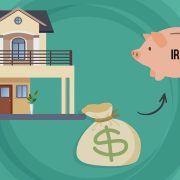Worried About Stock Market Risk? Diversify into a Self-Directed Real Estate IRA
For those who are worried about excessive stock market volatility, an allocation to real estate continues to prove itself an effective diversifier.
It’s still a risk investment, so prices may fall during periods of flight-to-safety. But historically these are short-lived, while the steady income stream from rent provides ballast.
Real estate investments can involve direct ownership of individual properties, or be indirect, through ownership of real estate investment trusts (REITs). Investors can also own real estate directly in taxable accounts or take the increasingly popular route of holding real estate within specially-set-up retirement accounts, called “self-directed retirement accounts.” The most popular of these is the Self-Directed Real Estate IRA.
Ownership of real estate within a Self-Directed Real Estate IRA allows the investor to combine the advantages of real estate as an asset class with the advantages of tax-advantaged investing – a powerful financial alloy.
Let’s consider each of their advantages, separately:
Advantages of real estate investing
- Steady stream of rental income.
- Increasing income over time as rents tend to increase year over year.
- Potential for capital appreciation.
- While dividend stocks also provide income and the potential for increasing income and capital appreciation, federal regulations limit the amount you can leverage a stock portfolio with margin lending. Real estate investors have much greater access to leverage, which can increase both income and total return on investment. (Greater leverage also magnifies downside risk, as well).
- Real estate investors constantly maintain, expand and upgrade the national housing stock, improving the standard of living for all Americans.
- Depreciation (in taxable accounts), which helps improve the cash flow from real estate investments. Investors can deduct a portion of their real estate income for wear and tear, in anticipation of the need for eventual replacement of roofs, carpeting, furnaces and other components. Depreciation does not apply in Self-Directed Real Estate IRAs, however, because the tax advantages in IRAs are even greater: Current income is not taxed at all. So, there’s nothing the Self-Directed Real Estate IRA investor needs to deduct against.
- Intrinsic value. Unlike paper assets, any of which can plummet to zero overnight – real estate has intrinsic value as a place to live, work, grow crops, mine, place billboards, cut timber or any number of other value-producing activities. Unlike stocks, a given real estate investment almost never becomes worthless.
- Tax-free exchanges. In taxable accounts, rental properties (of “like kind”) can be exchanged as often as you like, capital gains taxes deferred, under Section 1031 of the internal revenue code. In a Self-Directed Real Estate IRA or 401(k) or other tax-advantaged retirement account, there is no capital gains tax at all, except on amounts attributable to someone else’s money (borrowed money) in IRAs.
Advantages of Self-Directed IRAs and other retirement accounts
- Income attributable to investments made with your own money is not taxable in the current year. It’s either deferred, or in the case of assets in Roth accounts left in place at least five years, tax-free. You only have to pay current income taxes on income earned with someone else’s money – i.e., a mortgage.
- Capital gains taxes on gains attributable to your own money rather than borrowed funds are deferred, or in the case of assets in Roth accounts left in place at least five years, tax-free.
- Asset protection. Unlike assets held in personal taxable accounts, assets in self-directed retirement accounts, including Self-Directed Real Estate IRAs, enjoy substantial legal protection against the claims of creditors. Even if you personally go bankrupt, it is very difficult for creditors to touch assets in non-inherited retirement accounts.
- Limited liability. Real estate is, by its very nature, a liability-generating asset. Landlords can get sued for any number of things, real and imagined. But you personally cannot be held liable for any liabilities generated from within an IRA, since you are not a personal guarantor of IRA debts. Even if a plaintiff wins a judgement against the owner of the property – your IRA, not you, personally – they cannot then collect your personal assets. Collections are limited to the assets within the IRA, or the LLC or corporation that owns the property within the IRA.
Owning real estate within a Self-Directed Real Estate IRA allows the investor to combine the best of both worlds.
Disadvantages of Self-Directed Real Estate IRA Investing
The disadvantages are few, but include the following:
- Real estate is generally illiquid. It takes time and money to sell a real estate holding if you need to raise cash in a hurry.
- Real estate assets need maintenance. There are ongoing costs associated with maintaining a rental property. You will need to fix roofs, sinks, toilets, doors and windows. You will need to keep the wiring up to date, install new carpet and flooring, appliances and make rent ready repairs between tenants. Your rent prices and purchasing decisions need to account for these factors.
- Property taxes. You will need to pay property taxes to local or state governments, depending on the jurisdiction. Your total returns need to be enough to compensate you for the ongoing property tax costs.
- You will need to maintain landlord insurance, flood insurance and other types of insurance coverage to protect your investment.
- Income from non-Roth retirement accounts is taxed at ordinary income tax rates. Lower long-term capital gains taxes do not normally apply to distributions from IRAs and 401(k)s. But income from Roth accounts, once the assets have been in a Roth account at least five years, is tax-free.
- Required minimum distributions. IRAs are such a good deal, and the tax advantages so powerful, that Congress decreed that you cannot defer income and capital gains taxes on Traditional IRA investments forever. Except for Roth accounts, you must begin taking distributions and paying taxes on those distributions no later than April 1st of the year after the year in which you turn age 70½.
- Transaction restrictions. You have to use the tax advantages of an IRA for the purposes for which they are intended: To create income security for yourself and your family in retirement. Congress forbids transactions that tend toward self-dealing, or the enrichment of your immediate family. So, you cannot use your IRA or other retirement account to transact directly with yourself, your spouse, direct ascendants or descendants, or any fiduciary advisor who advises you on retirement matters.
Interested in learning more about Self-Directed IRAs? Contact American IRA, LLC at 866-7500-IRA (472) for a free consultation. Download our free guides or visit us online at www.AmericanIRA.com.











